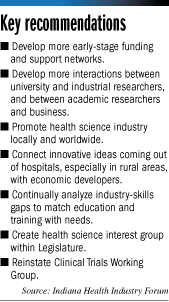Subscriber Benefit
As a subscriber you can listen to articles at work, in the car, or while you work out. Subscribe NowIndiana has taken “a giant step backward” in the availability of early-stage capital for life sciences companies, according to the Indiana Health Industry Forum—which also has a few ideas on how to reverse that development.
 The Indianapolis-based trade association unveiled a five-year strategy earlier this month, with a heavy focus on how to make more money available to life sciences innovators who are trying to prove their ideas have commercial potential.
The Indianapolis-based trade association unveiled a five-year strategy earlier this month, with a heavy focus on how to make more money available to life sciences innovators who are trying to prove their ideas have commercial potential.
For a while, that need for cash infusions of $50,000 to $250,000 was filled, in large part, by wealthy individuals called angel investors and before that stage by Indiana’s 21st Century Research and Technology Fund.
But angels have started investing at later stages, filling a gap left by venture capitalists who also are waiting longer before putting money into a company.
And the 21st Century Fund has less than half as much funding now as it did in 2008—and no longer offers matching grants for firms that win federal grants known as SBIR and STTR ( Small Business Innovation Research and Small Business Technology Transfer, respectively).
 Cothrel
Cothrel“Indiana has taken a giant step backward in early-stage capital over the last three to five years,” said Andy Cothrel, CEO of Indianapolis-based medical-device firm SonarMed Inc. He chaired the committee that drafted recommendations for improving capital formation for the Health Industry Forum’s strategy.
Cothrel praised Indianapolis-based BioCrossroads Inc., which started a $6 million seed fund in 2005 and just announced a second, $8.25 million seed fund in April. But there is still a need for capital at even earlier stages, to get companies ready for formal investments.
Cothrel said changes to the 21 Fund and changes by private investors all have been economically rational, but the cumulative unintended consequence is to leave early-stage life sciences companies starving for capital.
That’s a big problem for Indiana, he argued, because having a steady stream of “de-risked” companies is a key way Indiana can overcome some of its other natural disadvantages when it comes to attracting private investors.
Among the disadvantages: Few venture capital firms are based here; Indiana isn’t nearly as convenient for coastal venture capital firms as such life sciences hubs as Boston, New York, San Diego, San Francisco and Washington, D.C.; and few coastal venture capitalists want to invest the small amounts of money most Indiana life sciences companies are looking for—at least initially.
Companies typically use small, early-stage investments to conduct studies to see if their product ideas meet a need in the marketplace or have a chance of receiving reimbursement from Medicare and other health plans. Early money also can be used to hire a key person who can move the company forward.
“It’s money most investors are reluctant to write a check for because it’s questions that you have to get answered before you know you have a business,” Cothrel said.
So Cothrel’s committee at the Indiana Health Industry Forum called for creating a an early-stage funding mechanism focused exclusively on life sciences, with at least some of its funding coming from the state of Indiana. This funding entity would make both grants and return-based investments.
Also, the Health Industry Forum will work to build a statewide support system for early-stage companies, which would direct such firms to people—preferably in their geographic area—who can help them write SBIR or STTR grant applications, provide technical or regulatory review of their plans, or simply offer entrepreneurial mentoring.
Last, Cothrel’s committee recommended that the Health Industry Forum organize events to familiarize larger Indiana corporations with the early-stage life sciences companies in Indiana. Corporate funding has become an increasingly common way to fill the gaps left from state funding cuts and venture capitalists’ desire to wait longer before investing.
If Indiana doesn’t improve the funding environment for early-stage life sciences companies, Cothrel said, many will never get started and others will simply leave.
“If we don’t do a good job nurturing small companies,” he said, “they’re a lot more portable than big companies.”
Other parts of the Health Industry Forum’s strategy include renewed efforts to promote technological breakthroughs made in either industry or academia to investors and entrepreneurs, both around the state and elsewhere.•
Please enable JavaScript to view this content.
